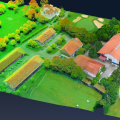
An aerial survey of New Zealand’s Alpine Fault, which runs almost the entire length of the South Island, using LiDAR revealed subtle features in the landscape formed by fault movement over hundreds and thousands of years. It provided scientists a better understanding of the nature of the Alpine Fault, one of New Zealand's biggest hazards, having created seven >7 magnitude quakes in the last 150 years, the last occurring in 2009.
The survey, flown and processed by NZ Aerial Mapping this year, covered a 34 kilometre-long and 1.6 kilometre-wide, high-uplift section of the fault from Whataroa to Franz Josef. LiDAR was also used in the natural hazards research platform-funded project to investigate about a 30km stretch of the western part of the Hope Fault from the upper reaches of the Hurunui River to the upper Hope River, much of it under beech forest.
According to GNS Science earthquake geologist and project leader, Robert Langridge, The results of the collaborative work between GNS Science and young researchers at Canterbury, Otago and Victoria universities had thrown up a few surprises. Earlier work had suggested the central section of the Alpine Fault had sections split into short, stepped, segments about one-kilometre long because of the way the fault reacted with the Earth's surface.
"With Lidar we were able to confirm that theory and also show some of the traces were quite extreme in their strike direction, accommodating lots of strike-slip [movement] and considerable amounts of reverse movement. So it has been able to confirm things that we sort of only dreamed about."
Excavation of a terrace across the fault there showed it last moved in 1717, confirming the date of the most recent rupture, he added.
"With Lidar we are realising a primary set of data to build other projects off. By knowing where the fault is and main traces, you can do slip-rate studies, trenching studies to date past quakes, and think about where to site deep-drilling projects. It's a new form of mapping technology that is going to lead the way for a decade or so," Langridge continued.







